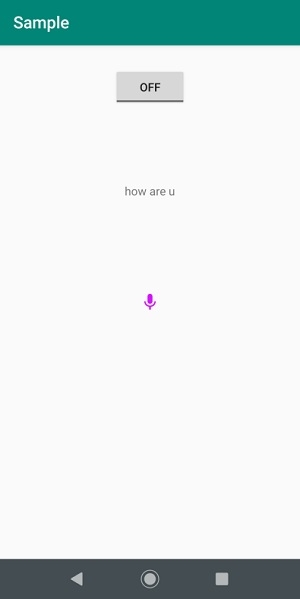
 Data Structure
Data Structure Networking
Networking RDBMS
RDBMS Operating System
Operating System Java
Java MS Excel
MS Excel iOS
iOS HTML
HTML CSS
CSS Android
Android Python
Python C Programming
C Programming C++
C++ C#
C# MongoDB
MongoDB MySQL
MySQL Javascript
Javascript PHP
PHP
- Selected Reading
- UPSC IAS Exams Notes
- Developer's Best Practices
- Questions and Answers
- Effective Resume Writing
- HR Interview Questions
- Computer Glossary
- Who is Who
How to develop a speech recognizer in android without Google API?
This example demonstrates how do I develop a speech recognizer in android without Google API.
Step 1 − Create a new project in Android Studio, go to File ⇒ New Project and fill all required details to create a new project.
Step 2 − Add the following code to res/layout/activity_main.xml.
<?xml version="1.0" encoding="utf-8"?> <RelativeLayout xmlns:android="http://schemas.android.com/apk/res/android" android:layout_width="match_parent" android:layout_height="match_parent" android:orientation="vertical" > <ImageView android:id="@+id/imageView1" android:layout_width="200dp" android:layout_height="200dp" android:layout_centerInParent="true" android:src="@drawable/ic_mic" /> <ProgressBar android:id="@+id/progressBar1" style="?android:attr/progressBarStyleHorizontal" android:layout_width="match_parent" android:layout_height="wrap_content" android:layout_alignParentLeft="true" android:layout_below="@+id/toggleButton1" android:layout_marginTop="28dp" android:paddingLeft="10dp" android:paddingRight="10dp" /> <TextView android:id="@+id/textView1" android:layout_width="wrap_content" android:layout_height="wrap_content" android:layout_below="@+id/progressBar1" android:layout_centerHorizontal="true" android:layout_marginTop="47dp" /> <ToggleButton android:id="@+id/toggleButton1" android:layout_width="wrap_content" android:layout_height="wrap_content" android:layout_alignParentTop="true" android:layout_centerHorizontal="true" android:layout_marginTop="26dp" android:text="ToggleButton" /> </RelativeLayout>
Step 3 − Add the following code to src/MainActivity.java
package app.com.sample;
import android.Manifest;
import android.content.Intent;
import android.content.pm.PackageManager;
import android.os.Bundle;
import android.speech.RecognitionListener;
import android.speech.RecognizerIntent;
import android.speech.SpeechRecognizer;
import android.support.annotation.NonNull;
import android.support.v4.app.ActivityCompat;
import android.support.v7.app.AppCompatActivity;
import android.util.Log;
import android.view.View;
import android.widget.CompoundButton;
import android.widget.ProgressBar;
import android.widget.TextView;
import android.widget.Toast;
import android.widget.ToggleButton;
import java.util.ArrayList;
public class MainActivity extends AppCompatActivity implements
RecognitionListener {
private static final int REQUEST_RECORD_PERMISSION = 100;
private TextView returnedText;
private ToggleButton toggleButton;
private ProgressBar progressBar;
private SpeechRecognizer speech = null;
private Intent recognizerIntent;
private String LOG_TAG = "VoiceRecognitionActivity";
@Override
protected void onCreate(Bundle savedInstanceState) {
super.onCreate(savedInstanceState);
setContentView(R.layout.activity_main);
returnedText = findViewById(R.id.textView1);
progressBar = findViewById(R.id.progressBar1);
toggleButton = findViewById(R.id.toggleButton1);
progressBar.setVisibility(View.INVISIBLE);
speech = SpeechRecognizer.createSpeechRecognizer(this);
Log.i(LOG_TAG, "isRecognitionAvailable: " + SpeechRecognizer.isRecognitionAvailable(this));
speech.setRecognitionListener(this);
recognizerIntent = new Intent(RecognizerIntent.ACTION_RECOGNIZE_SPEECH);
recognizerIntent.putExtra(RecognizerIntent.EXTRA_LANGUAGE_PREFERENCE,"US-en");
recognizerIntent.putExtra(RecognizerIntent.EXTRA_LANGUAGE_MODEL, RecognizerIntent.LANGUAGE_MODEL_FREE_FORM);
recognizerIntent.putExtra(RecognizerIntent.EXTRA_MAX_RESULTS, 3);
toggleButton.setOnCheckedChangeListener(new CompoundButton.OnCheckedChangeListener() {
@Override
public void onCheckedChanged(CompoundButton buttonView, boolean isChecked) {
if (isChecked) {
progressBar.setVisibility(View.VISIBLE);
progressBar.setIndeterminate(true);
ActivityCompat.requestPermissions (MainActivity.this, new String[]{Manifest.permission.RECORD_AUDIO},
REQUEST_RECORD_PERMISSION);
} else {
progressBar.setIndeterminate(false);
progressBar.setVisibility(View.INVISIBLE);
speech.stopListening();
}
}
});
}
@Override
public void onRequestPermissionsResult(int requestCode, @NonNull String[] permissions, @NonNull int[] grantResults) {
super.onRequestPermissionsResult(requestCode, permissions, grantResults);
switch (requestCode) {
case REQUEST_RECORD_PERMISSION:
if (grantResults.length > 0 && grantResults[0]== PackageManager.PERMISSION_GRANTED) {
speech.startListening(recognizerIntent);
} else {
Toast.makeText(MainActivity.this, "Permission Denied!", Toast .LENGTH_SHORT).show();
}
}
}
@Override
public void onResume() {
super.onResume();
}
@Override
protected void onPause() {
super.onPause();
}
@Override
protected void onStop() {
super.onStop();
if (speech != null) {
speech.destroy();
Log.i(LOG_TAG, "destroy");
}
}
@Override
public void onBeginningOfSpeech() {
Log.i(LOG_TAG, "onBeginningOfSpeech");
progressBar.setIndeterminate(false);
progressBar.setMax(10);
}
@Override
public void onBufferReceived(byte[] buffer) {
Log.i(LOG_TAG, "onBufferReceived: " + buffer);
}
@Override
public void onEndOfSpeech() {
Log.i(LOG_TAG, "onEndOfSpeech");
progressBar.setIndeterminate(true);
toggleButton.setChecked(false);
}
@Override
public void onError(int errorCode) {
String errorMessage = getErrorText(errorCode);
Log.d(LOG_TAG, "FAILED " + errorMessage);
returnedText.setText(errorMessage);
toggleButton.setChecked(false);
}
@Override
public void onEvent(int arg0, Bundle arg1) {
Log.i(LOG_TAG, "onEvent");
}
@Override
public void onPartialResults(Bundle arg0) {
Log.i(LOG_TAG, "onPartialResults");
}
@Override
public void onReadyForSpeech(Bundle arg0) {
Log.i(LOG_TAG, "onReadyForSpeech");
}
@Override
public void onResults(Bundle results) {
Log.i(LOG_TAG, "onResults");
ArrayList<String> matches = results .getStringArrayList(SpeechRecognizer.RESULTS_RECOGNITION);
String text = "";
for (String result : matches)
text = result + "
";
returnedText.setText(text);
}
@Override
public void onRmsChanged(float rmsdB) {
Log.i(LOG_TAG, "onRmsChanged: " + rmsdB);
progressBar.setProgress((int) rmsdB);
}
public static String getErrorText(int errorCode) {
String message;
switch (errorCode) {
case SpeechRecognizer.ERROR_AUDIO:
message = "Audio recording error";
break;
case SpeechRecognizer.ERROR_CLIENT:
message = "Client side error";
break;
case
SpeechRecognizer.ERROR_INSUFFICIENT_PERMISSIONS:
message = "Insufficient permissions";
break;
case SpeechRecognizer.ERROR_NETWORK:
message = "Network error";
break;
case SpeechRecognizer.ERROR_NETWORK_TIMEOUT:
message = "Network timeout";
break;
case SpeechRecognizer.ERROR_NO_MATCH:
message = "No match";
break;
case SpeechRecognizer.ERROR_RECOGNIZER_BUSY:
message = "RecognitionService busy";
break;
case SpeechRecognizer.ERROR_SERVER:
message = "error from server";
break;
case SpeechRecognizer.ERROR_SPEECH_TIMEOUT:
message = "No speech input";
break;
default:
message = "Didn't understand, please try
again.";
break;
}
return message;
}
}
Step 4 − Add the following code to androidManifest.xml
<?xml version="1.0" encoding="utf-8"?> <manifest xmlns:android="http://schemas.android.com/apk/res/android" package="app.com.sample"> <uses-permission android:name="android.permission.RECORD_AUDIO"/> <uses-permission android:name="android.permission.INTERNET" /> <application android:allowBackup="true" android:icon="@mipmap/ic_launcher" android:label="@string/app_name" android:roundIcon="@mipmap/ic_launcher_round" android:supportsRtl="true" android:theme="@style/AppTheme"> <activity android:name=".MainActivity"> <intent-filter> <action android:name="android.intent.action.MAIN" /> <category android:name="android.intent.category.LAUNCHER" /> </intent-filter> </activity> </application> </manifest>
Let's try to run your application. I assume you have connected your actual Android Mobile device with your computer. To run the app from android studio, open one of your project's activity files and click Run ![]() icon from the toolbar. Select your mobile device as an option and then check your mobile device which will display your default screen −
icon from the toolbar. Select your mobile device as an option and then check your mobile device which will display your default screen −


Click here to download the project code.

